Whether you’re a seasoned aquarist or just getting into tropical snails, cerith snails are a fantastic addition to your tank. From their perfect living conditions to their care needs, getting to know these little guys will take your aquarium game to the next level.
Cerith snails are like the unsung heroes of your tank, quietly munching away on algae and keeping things clean. To keep them happy and healthy, aim for a water temperature between 74 to 80°F, a pH level of 8.1 to 8.4, and water hardness around 8 to 12 dKH. Also, keep the specific gravity between 1.023 to 1.025. When all these factors are in place, your snails won’t just survive—they’ll thrive.
Sizing and space are key, too. These snails usually have shells about 1/2 inch long, so plan for at least 1 gallon of water for every 2 snails. This ensures they’ve got enough room to do their thing, helping create a balanced and beautiful aquatic environment. That’s the magic of aquarism—bringing together all these little details to create a living work of art.
Cerith Snail Species Profile
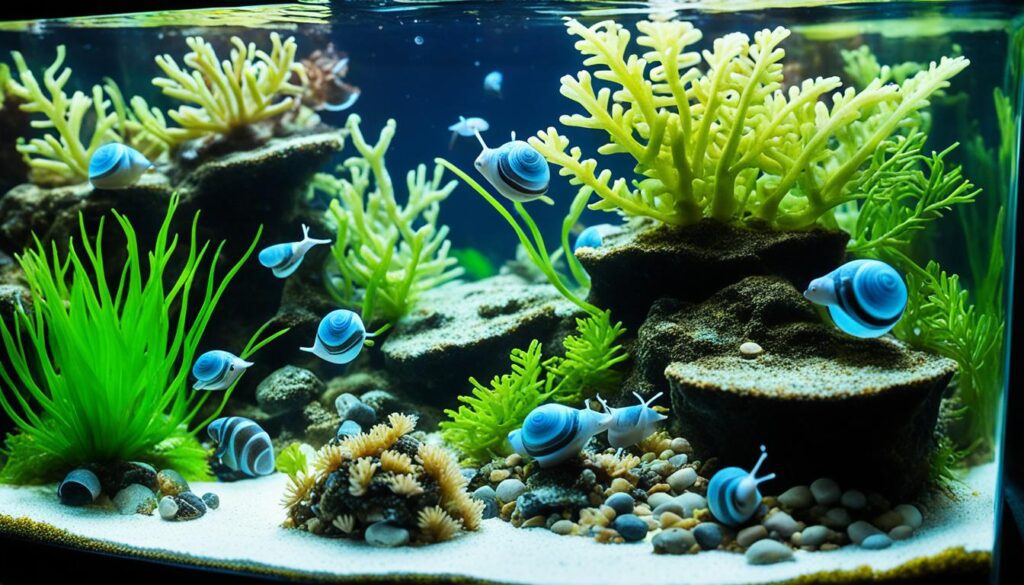
For those of us drawn to home aquarium ecosystems, the cerith snail introduction is key. They boost our aquariums’ health and aesthetics. Besides looking good, they play a crucial role in keeping the environment clean. They munch on algae, detritus, and leftover food. They come from various places like the Indo-Pacific and Caribbean reefs. Their ability to thrive in different habitats, from mangroves to sandy flats, is impressive.
My interest in these aquarium snails started after I watched them work at night. Cerith snails, active mostly at night, intrigued me as they cleaned the tank diligently. Their peaceful nature fits perfectly into the calm underwater realm we aim to create.
What grabs enthusiasts’ attention is not only their cleaning ability but their beautiful shells. The shells’ detailed spirals and earthy tones catch the eye, adding natural beauty to tanks. Cerith snails are also tough, handling transportation stress well, becoming favorites for both beginners and experienced keepers.
Characteristic |
Detail |
|---|---|
Maximum Size |
Up to 15cm (5.9″), typical species around 2.5cm (1″) |
Temperature Range |
Tropical, 23-27°C (73-81°F) |
Water Parameters |
SG: 1.020-1.025, pH: 8.1-8.4 |
Behavior |
Nocturnal, active substrate foragers |
Feeding Habits |
Consumes algae, detritus, and enhanced diets including brineshrimp, Mysis shrimp, and krill |
Understanding cerith snails’ needs is crucial for their care in your tank. Watching them work is calming and good for the aquarium. With the right care, they become vital to our aquariums’ life-support systems.
Lifespan of Your Cerith Snail
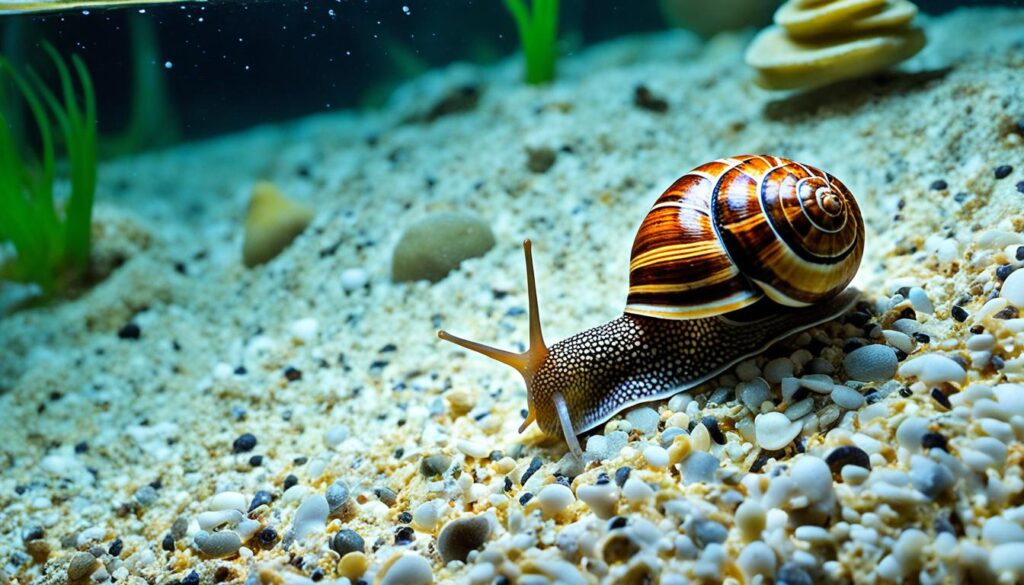
As an aquarium lover, I’ve learned a lot about cerith snails. Knowing how to care for them boosts your aquarium’s lifespan. Cerith snails help control algae and keep the substrate mixed. With the right care, they can live up to two years.
To help other fans, I want to share some key steps. These will help your cerith snails live longer and healthier:
- Acclimate Your Snail Properly: The drip method is best for adding new snails. It slowly introduces them to your tank’s conditions, reducing stress.
- Monitor Water Quality: Good water is crucial. Check your tank often for the right pH, ammonia, nitrites, and nitrates levels.
- Ensure Adequate Food Supply: Cerith snails eat algae and waste. Ensure your tank has enough food, and add more if needed.
Here’s a quick guide on products that can help your snail:
Product |
Description |
Benefits |
|---|---|---|
OceanMagik Phytoplankton |
Live phytoplankton that should be stored cold. It lasts about four weeks. |
It feeds corals and other filter-feeders, helping to clean the water. |
Reef Copepods |
These live copepods work best when added at night. This lowers the risk of them being eaten. |
They increase the diversity of life in your tank and feed cerith snails. |
Looking closely at these care tips and products shows their value. They don’t just help your cerith snails. They improve your whole aquarium’s health. Follow these steps for a happier, longer-lived tank community!
Optimal Water Parameters for Cerith Snails
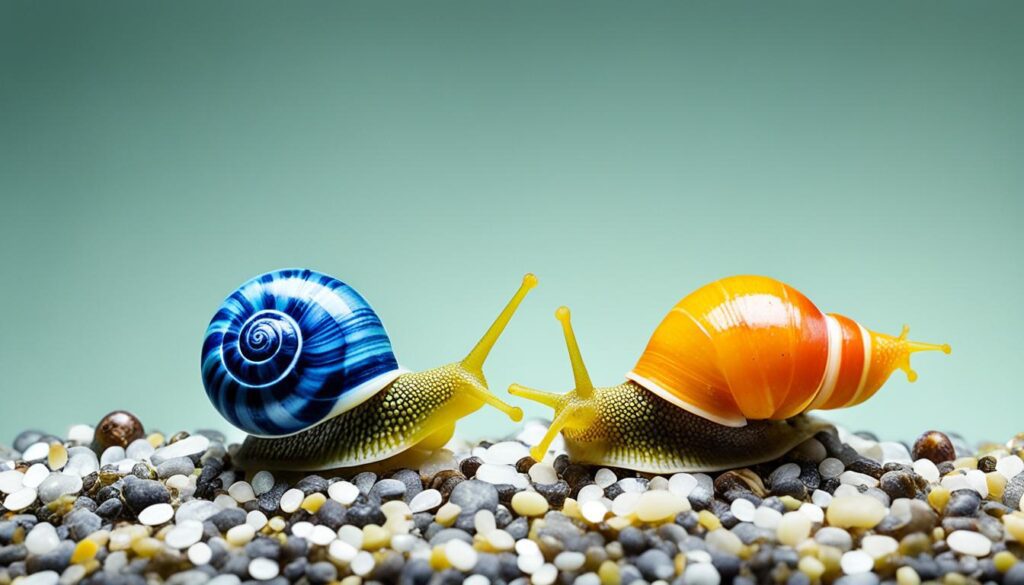
Keeping Cerith snails healthy in your tank means knowing the right water conditions. It’s important to watch the tank’s temperature, pH, hardness, and specific gravity closely. These are key for creating a home similar to their ocean environment, helping them to do well.
Importance of Maintaining the Right Temperature
Cerith snails do best in temperatures between 74 and 80°F. This range suits their tropical origins and supports their health. It ensures they remain lively and well in your aquarium.
pH Levels: Ensuring the Perfect Balance
A stable pH of 8.1 to 8.4 is essential for Cerith snails. This slight alkalinity avoids stress, fostering better health.
Understanding Water Hardness and Specific Gravity
Keep water hardness for these snails between 8 and 12 dKH. Proper hardness is crucial for their shell growth, impacting their survival and health. Also, maintain specific gravity at 1.023 to 1.025. This mirrors the ocean and is vital for their wellbeing.
Parameter |
Range |
|---|---|
Temperature (°F) |
74 – 80 |
pH |
8.1 – 8.4 |
Water Hardness (dKH) |
8 – 12 |
Specific Gravity |
1.023 – 1.025 |
Creating the Ideal Tank Environment
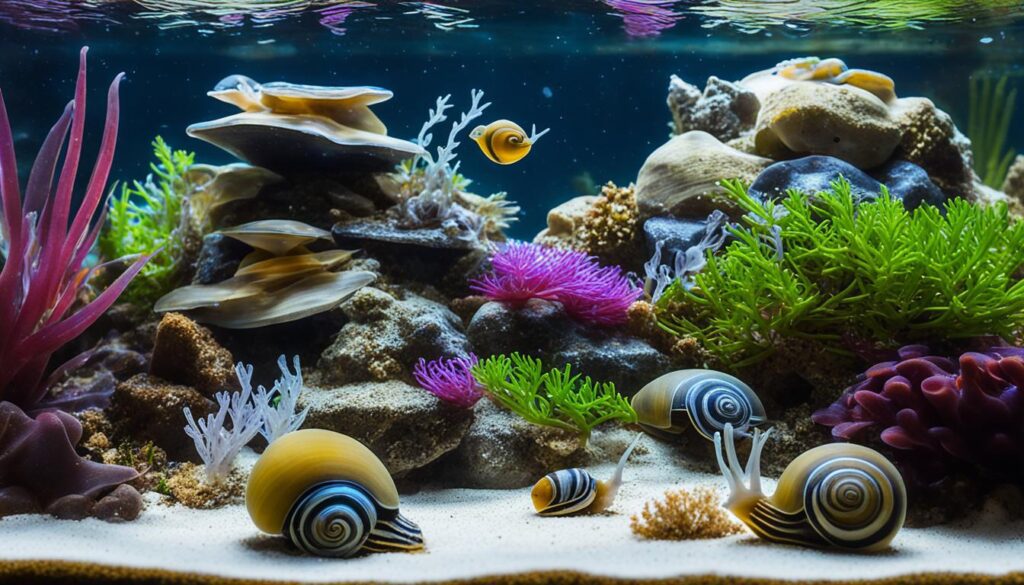
To make sure your cerith snails are happy, you need to create a cerith snail habitat that feels like their natural home. This includes choosing the right tank substrate, and deciding on the tank’s layout and size. When their habitat fits their needs, cerith snails can clean your tank well and help keep your ecosystem balanced.
Choosing the Right Substrate and Providing Hiding Spots
Choosing a good tank substrate is key for cerith snails. They love a deep sand bed, which lets them burrow and look for food, just like they do in the wild. This type of substrate helps them eat and also helps keep your tank clean by encouraging good bacteria.
Having places to hide is also very important. Things like live rock formations give them a safe place to go when they’re scared or not looking for food. These hiding spots make them feel more at home and less stressed in your tank.
Here is a comparison of cerith snails’ hiding behavior with other popular aquarium snails:
Snail Type |
Hiding Behavior |
Preferred Hiding Spots |
|---|---|---|
Cerith Snails |
Frequent burrowers, especially in sandy substrates |
Live rocks, macroalgal beds |
Nerite Snails |
Occasional, prefers crevices |
Plant leaves, tank glass |
Nassarius Snails |
Primarily sand burrowers |
Deep sand beds |
Margarita Snails |
Active at night, less during the day |
Algal-covered rocks |
Turbo Snails |
Minimal hiding, large size reduces need |
Open space, stable rock formations |
How Tank Size Influences Cerith Snail Well-being
For cerith snail habitat, the size of the tank is important. A small tank might be ok for a few snails. But too many snails in a small space can cause problems. They might not find enough food or space to be happy. I suggest using at least a 5-gallon tank for cerith snails. A good rule is 1-2 snails for every gallon of water. This gives each snail enough room to roam and find food, avoiding stress and hunger.
Keeping the right sized tank, with the right tank substrate and hiding places, is key. It keeps your cerith snails healthy and helps them clean your tank efficiently. This makes them a great part of any aquarium.
Nutritional Needs of Cerith Snails
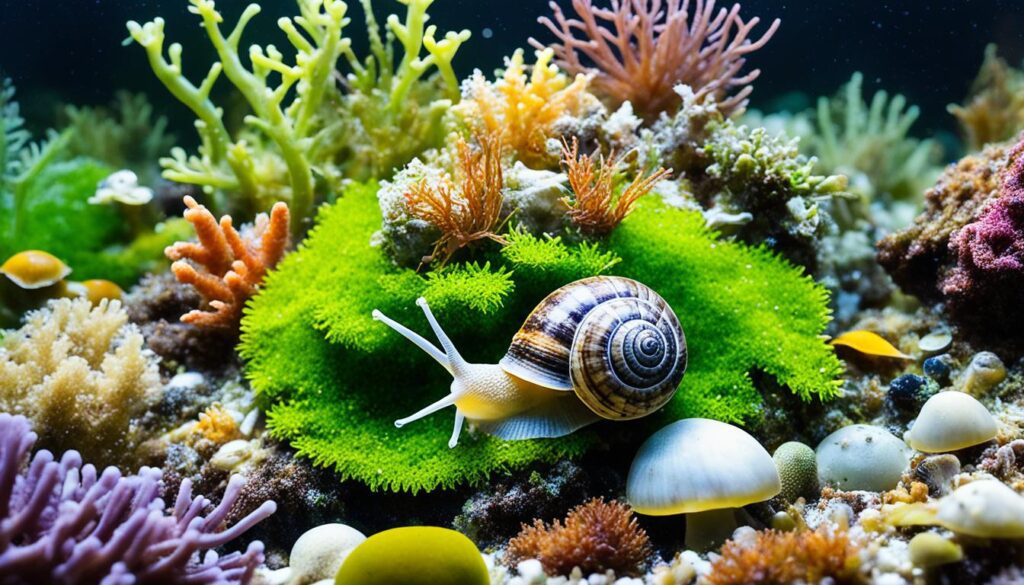
Understanding the cerith snail diet and their snail nutrition requirements is crucial for maintaining a healthy aquarium environment. Cerith snails are top-notch algae eaters. They help manage algae and keep the tank clean.
The Natural Diet of the Cerith Snail
Cerith snails eat organic debris, which includes uneaten fish food, decayed plants, and various algae. They naturally clean the tank by breaking down waste. For more on their diet and benefits, visit Aquarium Source.
When to Supplement Your Cerith Snail’s Diet
In clean tanks or those with an effective clean-up crew, natural food may be scarce. Supplementing their diet is then necessary. Place dried seaweed or macroalgae strips in their usual spots to ensure they get enough to eat.
Snail Type |
Recommended Quantity per 3 Gallons |
Special Dietary Notes |
|---|---|---|
Regular Cerith Snails |
1 |
No special requirements; avoid overpopulation to prevent starvation |
Dwarf Cerith Snails |
10 |
Smaller size but similar diet as regular cerith snails |
Conchs and Nassarius Snails |
Varies |
Require larger and more specific feeding practices |
It’s critical to balance snail population with tank size. Fewer snails at the start can prevent nutrient depletion that promotes algae growth. Keep an eye on snail health and shell condition. Adjust their diet to ensure they get the right nutrition.
Cerith snails are easy to care for, but don’t ignore their dietary needs. A balanced diet keeps them effective at managing algae. It also makes for a healthier aquatic ecosystem.
Understanding the Social Nature of Cerith Snails
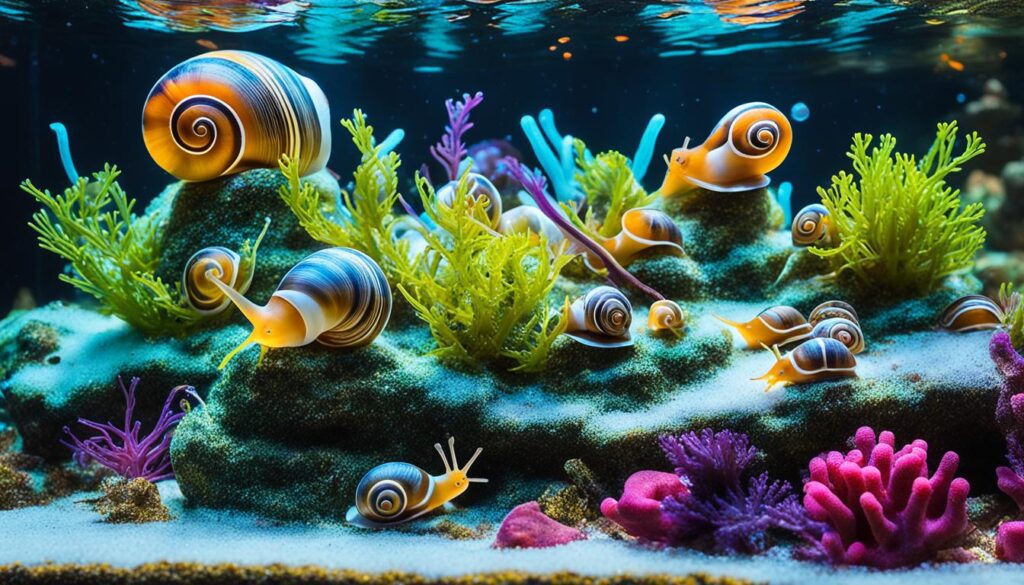
Cerith snails are peaceful creatures. This makes them great for living with many other sea species without issues. They enjoy exploring or hiding during the day and come out at night.
These snails are calm and avoid fights, perfect for community tanks. However, be cautious when adding creatures that might bother them. Even though cerith snails are not the most active or clean the best, they help control algae by moving around the tank.
Adapting to new places can take cerith snails some time. They might not move much at first and hide in the sand if they feel stressed. Despite being less seen, they play a big role in keeping the tank clean by working on rocks and other surfaces.
For cerith snails to thrive, they need a peaceful and spacious tank. Avoid placing them with aggressive fish to prevent stress. Giving them plenty of hiding spots and sandy floors will help them feel at home.
Knowing how cerith snails like to live helps in creating a better aquarium. They not only make your tank more interesting but also help keep the ecosystem in check. They are valuable in both big and small tanks.
Selecting Compatible Tank Mates for Cerith Snails
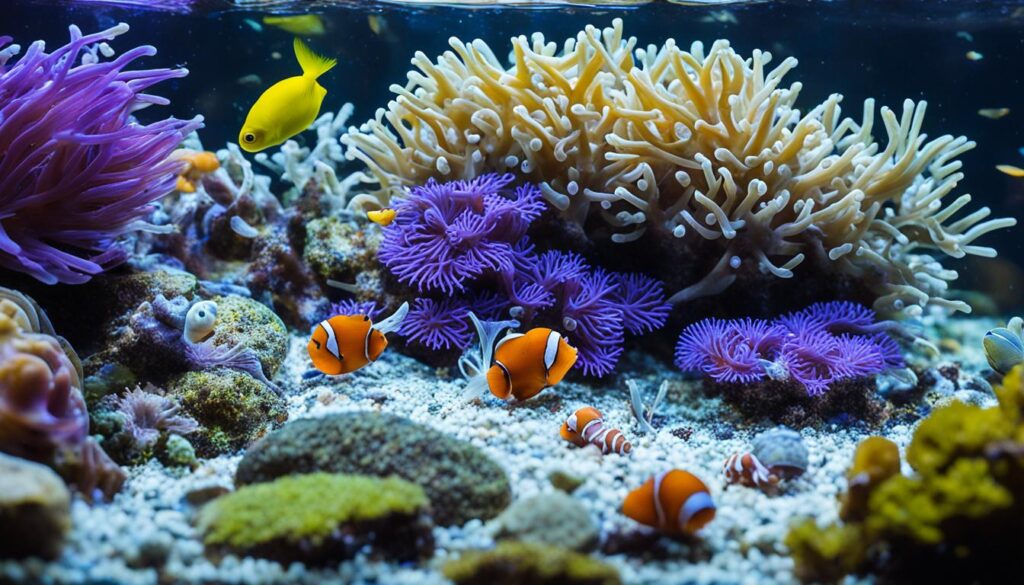
When setting up an aquarium, picking creatures that live well together is key. For those with Cerith snails, knowing which cerith snail tank mates are friendly and which aquarium predators to stay away from is vital. This ensures a peaceful tank environment.
Identifying Peaceful Tank Mates
Cerith snails need a peaceful home to thrive. It’s important to choose snail-friendly fish and other invertebrates that don’t fight over food or space. Fish that don’t bother others, soft corals, sponges, and starfish that don’t eat snails are good choices. They live well with Cerith snails, making the tank’s life diverse yet safe.
Giant clams and various shrimp are also great. They not only look good but help keep the tank clean. Plus, they’re safe to live with Cerith snails.
Common Predators and Aggressive Species to Avoid
Picking the right tank mates also means knowing who could harm Cerith snails. Avoid big, aggressive fish that might eat snails. Predatory crabs and fish that hunt invertebrates are known aquarium predators. Staying away from these is crucial for your snails’ safety and health.
Here’s a look at different snails and their fit with Cerith snails, based on their living needs and actions:
Snail Type |
Temperature Range (°F) |
Lifespan |
Compatibility With Cerith Snails |
|---|---|---|---|
Zebra Turbo |
74 – 80 |
Longer Lifespan |
Compatible |
Mexican Turbo |
74 – 80 |
Short Lifespan |
Less Compatible |
Margarita |
50 – 65 |
Varies with Temperature |
Less Compatible |
Saltwater Nerite |
Up to 82 |
Over 5 Years |
Highly Compatible |
Trochus |
74 – 80 |
Up to 10 Years |
Highly Compatible |
In conclusion, Cerith snails are quite easy to look after. But choosing their tank mates should be done with care. This helps avoid danger and supports a healthy, thriving underwater world.
Breeding Cerith Snails and Caring for Their Offspring
My fascination with cerith snail breeding continues to grow. Understanding their sexual differences is key for identifying males and females. This is crucial for successful spawning in aquariums. The male snails perform a complex mating dance. Afterward, the female lays transparent eggs in rock crevices or substrate. Watching over these eggs in my tank is a must, as they can be at risk from other tank mates.
Cerith snail eggs usually hatch in about four days, but not always. Despite laying many eggs, hatch rates can vary, showing how unpredictable life can be in a tank. The hatchlings are tiny yet quick, easily exploring their new world. By adding calcium and providing the right algae, I’ve seen better growth and survival rates in these small snails. But, breeding success is hit or miss, sometimes leading to many offspring, other times not.
My tank holds snails from the Caribbean to the Sea of Cortez, thanks to the wide variety available in the U.S. To encourage breeding, I keep the water at specific levels of gravity, pH, and temperature. However, even with effort, snails can easily be bought from stores, simplifying the process. The challenge of breeding cerith snails is both rewarding and engaging, enriching my hobby as an aquarist.








